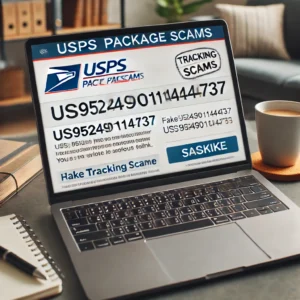Introduction
The internet is flooded with scams, and one of the latest phishing tricks involves a fake USPS tracking number, US9524901144737. This scam targets unsuspecting individuals by sending fake package delivery alerts. The message, disguised as a legitimate USPS notification, urges recipients to resolve an issue with their delivery by clicking on a suspicious link. The consequences can be devastating, from stolen personal information to financial losses.
In this article, we’ll uncover how the scam works, how to identify it, and steps to protect yourself.
What Is US9524901144737?
US9524901144737 is not a real USPS tracking number. Instead, scammers use it as a tool to create a sense of legitimacy. The tracking number mimics genuine USPS formats, tricking victims into thinking the notification is authentic.
The scam typically starts with an email, text, or voicemail claiming your package couldn’t be delivered due to an address issue. The fraudulent message often includes a link that redirects you to a fake USPS website designed to steal your personal information.
Why Do Scammers Use US9524901144737?
Scammers exploit fake tracking numbers like US9524901144737 for psychological reasons:
- Familiarity: It resembles real tracking numbers, making it believable.
- Urgency: They create pressure, prompting quick action before you think twice.
- Trust: USPS is a trusted name, and people often expect package deliveries, making the scam feel credible.
How the Scam Operates

The US9524901144737 scam is sophisticated, unfolding in several stages:
1. Fake Alerts
You receive a message that looks like it’s from USPS, stating that your package couldn’t be delivered due to an address issue. The message might read:
“USPS Alert: A package addressed to you was returned due to an insufficient address. Click here to update your address for redelivery: [malicious link].”
The tracking number, US9524901144737, is prominently displayed to give the illusion of authenticity.
2. Redirection to a Fake Website
Clicking the link takes you to a website that looks like USPS’s official page. The fake site copies the USPS branding, logos, and layout to deceive you. However, a closer inspection of the URL will reveal inconsistencies, such as:
- “USPS-secure365.com”
- “USPS-service.com”
These small variations are easy to miss but critical to identifying the scam.
3. Request for Personal Information
The fake site asks for your personal details, such as:
- Full name
- Address
- Phone number
- Credit card information (to pay a small “redelivery fee”)
Once you provide this data, scammers have everything they need to commit identity theft or financial fraud.
4. Exploitation of Stolen Data
Scammers use the information in multiple ways:
- Selling it on the dark web.
- Accessing your bank accounts.
- Opening fraudulent credit cards in your name.
- Targeting you with further phishing attempts.
How to Spot the US9524901144737 Scam
Key Warning Signs
- Unexpected Package Alerts: Be cautious if you aren’t expecting a delivery.
- Generic Greetings: Scams often use “Dear Customer” instead of your name.
- Suspicious Links: Hover over links to check the URL before clicking. Look for official domains like “usps.com.”
- Urgency: Scammers create pressure to act immediately.
- Requests for Personal Information: Legitimate USPS messages never ask for sensitive details online.
Steps to Verify a Real USPS Tracking Number
- Visit the official USPS website and manually enter the tracking number.
- Look for secure URLs starting with “https://” and ending with “usps.com.”
- Contact USPS directly through their customer service to confirm any delivery issues.
How to Protect Yourself from Scams
Practical Tips
- Avoid Clicking Suspicious Links: Always verify URLs before clicking.
- Use Strong Passwords: Protect your online accounts with unique, secure passwords.
- Enable Two-Factor Authentication: Add an extra layer of security to your accounts.
- Install Antivirus Software: Use trusted programs to detect malware.
- Monitor Your Credit: Check your credit report regularly for unauthorized activity.
What to Do If You’ve Fallen Victim
- Contact Your Bank: Report any unauthorized transactions and freeze your account if necessary.
- Place a Fraud Alert: Notify credit bureaus like Experian, Equifax, or TransUnion.
- Change Your Passwords: Update passwords for all affected accounts.
- Report the Scam: File a complaint with the Federal Trade Commission (FTC).
Real-Life Example: How a Victim Got Tricked
Jane, a frequent online shopper, received a text with tracking number US9524901144737. Believing it was a legitimate USPS notification, she clicked the link and entered her details. Within hours, her bank account was compromised, and fraudulent charges appeared on her credit card.
FAQs About the US9524901144737 Scam
What is US9524901144737?
It’s a fake USPS tracking number used in phishing scams to steal personal information.
How can I tell if a USPS message is real?
Check the sender’s email or phone number, verify the link’s URL, and contact USPS directly if unsure.
What should I do if I entered my information?
Immediately contact your bank, change your passwords, and monitor your credit for suspicious activity.
Can scammers access my accounts if I clicked the link?
If you entered personal details, they could use that information to commit fraud. Take action quickly to minimize damage.
Final Thoughts
The US9524901144737 scam is a stark reminder of how sophisticated phishing schemes have become. By staying informed and cautious, you can protect yourself from falling victim. Always verify suspicious messages, avoid sharing personal information online, and report scams to prevent others from being targeted.







